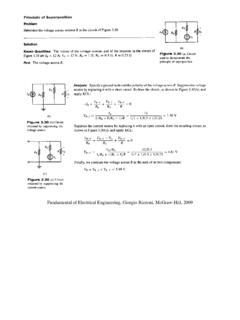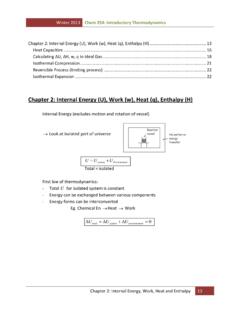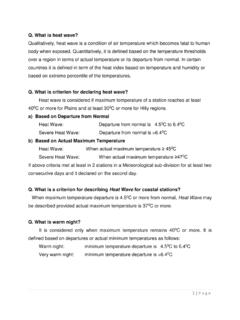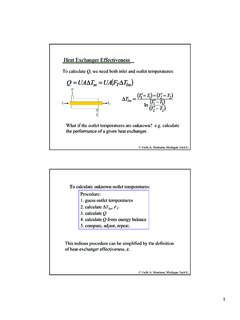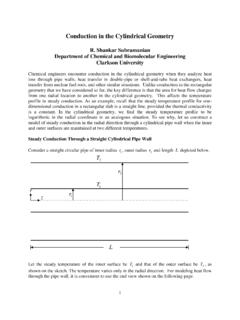Transcription of HEAT CONDUCTION EQUATION H - Wright State University
1 heat CONDUCTIONEQUATIONHeat transfer has directionas well as rate of heat conduc -tion in a specified direction is proportional to the temperature gradient,which is the rate of change in temperature with distance in that CONDUCTION in a medium, in general, is three-dimensional and time depen-dent, and the temperature in a medium varies with position as well as time, thatis,T T(x,y,z,t). heat CONDUCTION in a medium is said to be steadywhen thetemperature does not vary with time, and unsteadyor transientwhen it CONDUCTION in a medium is said to be one-dimensionalwhen CONDUCTION issignificant in one dimension only and negligible in the other two primary di-mensions,two-dimensionalwhen CONDUCTION in the third dimension is negligi-ble, and three-dimensionalwhen CONDUCTION in all dimensions is start this chapter with a description of steady, unsteady, and multidimen-sional heat CONDUCTION .
2 Then we derive the differential EQUATION that governsheat CONDUCTION in a large plane wall, a long cylinder, and a sphere, and gener-alize the results to three-dimensional cases in rectangular, cylindrical, and spher-ical coordinates. Following a discussion of the boundary conditions, we presentthe formulation of heat CONDUCTION problems and their solutions. Finally, weconsider heat CONDUCTION problems with variable thermal chapter deals with the theoretical and mathematical aspects of heatconduction, and it can be covered selectively, if desired, without causing a sig-nificant loss in continuity. The more practical aspects of heat CONDUCTION arecovered in the following two 2 OBJECTIVES When you finish studying this chapter,you should be able to.
3 Understand multidimensionalityand time dependence of heattransfer, and the conditions underwhich a heat transfer problem can be approximated as beingone-dimensional, Obtain the differential equationof heat CONDUCTION in various co-ordinate systems, and simplify itfor steady one-dimensional case, Identify the thermal conditions on surfaces, and express themmathematically as boundary and initial conditions, Solve one-dimensional heat CONDUCTION problems and obtainthe temperature distributionswithin a medium and the heat flux, Analyze one-dimensional heatconduction in solids that involveheat generation, and Evaluate heat CONDUCTION insolids with temperature-dependent thermal 1/5/10 10:45 AM Page 6364 heat CONDUCTION EQUATION2 1 INTRODUCTIONIn Chapter 1 heat CONDUCTION was defined as the transfer of thermal energyfrom the more energetic particles of a medium to the adjacent less energeticones.
4 It was stated that CONDUCTION can take place in liquids and gases as wellas solids provided that there is no bulk motion heat transfer and temperature are closely related, they are of a dif-ferent nature. Unlike temperature, heat transfer has direction as well as mag-nitude, and thus it is a vectorquantity (Fig. 2 1). Therefore, we must specifyboth direction and magnitude in order to describe heat transfer completely ata point. For example, saying that the temperature on the inner surface of a wallis 18 C describes the temperature at that location fully. But saying that theheat flux on that surface is 50 W/m2immediately prompts the question inwhat direction? We can answer this question by saying that heat conductionis toward the inside (indicating heat gain) or toward the outside (indicatingheat loss).
5 To avoid such questions, we can work with a coordinate system and indicatedirection with plus or minus signs. The generally accepted convention is thatheat transfer in the positive direction of a coordinate axis is positive and in theopposite direction it is negative. Therefore, a positive quantity indicates heattransfer in the positive direction and a negative quantity indicates heat trans-fer in the negative direction (Fig. 2 2).The driving force for any form of heat transfer is the temperature difference,and the larger the temperature difference, the larger the rate of heat heat transfer problems in engineering require the determination of thetemperature distribution(the variation of temperature) throughout the mediumin order to calculate some quantities of interest such as the local heat transferrate, thermal expansion, and thermal stress at some critical locations at speci-fied times.
6 The specification of the temperature at a point in a medium first re-quires the specification of the location of that point. This can be done bychoosing a suitable coordinate system such as the rectangular, cylindrical,orsphericalcoordinates, depending on the geometry involved, and a convenientreference point (the origin).The locationof a point is specified as (x,y,z) in rectangular coordinates, as(r,f,z) in cylindrical coordinates, and as (r,f,u) in spherical coordinates,where the distances x,y,z, and rand the angles fand uare as shown in Fig. 2 3. Then the temperature at a point (x,y,z) at time tin rectangular coor-dinates is expressed as T(x,y,z, t). The best coordinate system for a givengeometry is the one that describes the surfaces of the geometry best.
7 For example, a parallelepiped is best described in rectangular coordinates since each surface can be described by a constant value of the x-,y-, or z-coordinates. A cylinder is best suited for cylindrical coordinates since itslateral surface can be described by a constant value of the radius. Similarly,the entire outer surface of a spherical body can best be described by a con-stant value of the radius in spherical coordinates. For an arbitrarily shapedbody, we normally use rectangular coordinates since it is easier to deal withdistances than with notation just described is also used to identify the variables involved in a heat transfer problem. For example, the notation T(x,y,z,t) implies thatthe temperature varies with the space variables x,y, and zas well as time.
8 Magnitude oftemperatureat a point A(no direction)Hotbakedpotato50 C80 W/ m2 AMagnitude anddirection of heatflux at the samepointFIGURE 2 1 heat transfer has direction as well as magnitude, and thus it is a = 500 W Hotmedium0 LxColdmediumQ = 500 W FIGURE 2 2 Indicating direction for heat transfer(positive in the positive direction;negative in the negative direction). 1/5/10 10:45 AM Page 6465 CHAPTER 2 The notation T(x), on the other hand, indicates that the temperature varies inthe x-direction only and there is no variation with the other two space coordi-nates or versus Transient heat TransferHeat transfer problems are often classified as being steady(also called steady- State ) or transient(also called unsteady).
9 The term steadyimplies no changewith time at any point within the medium, while transientimplies variationwith timeor time , the temperature or heat flux remainsunchanged with time during steady heat transfer through a medium at any location, although both quantities may vary from one location to another (Fig. 2 4). For example, heat transfer through the walls of a house is steadywhen the conditions inside the house and the outdoors remain constant forseveral hours. But even in this case, the temperatures on the inner and outersurfaces of the wall will be different unless the temperatures inside and out-side the house are the same. The cooling of an apple in a refrigerator, on theother hand, is a transient heat transfer process since the temperature at anyfixed point within the apple will change with time during cooling.
10 Duringtransient heat transfer, the temperature normally varies with time as well asposition. In the special case of variation with time but not with position, thetemperature of the medium changes uniformlywith time. Such heat transfersystems are called lumped systems. A small metal object such as a thermo-couple junction or a thin copper wire, for example, can be analyzed as alumped system during a heating or cooling heat transfer problems encountered in practice are transientin nature,but they are usually analyzed under some presumed steadyconditions sincesteady processes are easier to analyze, and they provide the answers to ourquestions. For example, heat transfer through the walls and ceiling of a typi-cal house is never steady since the outdoor conditions such as the temperature,the speed and direction of the wind, the location of the sun, and so on, changeconstantly.

